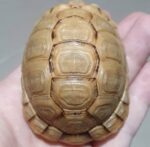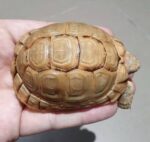Description
Kleinmann’s tortoise (Testudo kleinmanni), also called commonly the Egyptian tortoise for sale, Leith’s tortoise, and the Negev tortoise, is a critically endangered species of cryptodire turtle in the family Testudinidae. The species is native to Libya and possibly extinct in Egypt. The species was once more widespread, but its numbers are now dwindling, and complete extinction in the wild is a looming threat unless more actions are taken to protect this species.
Etymology
The specific name, kleinmanni, is in honor of Edouard Kleinmann, a French stockbroker who collected the holotype in 1875.[4]: 143
The specific name, werneri (of the synonym Testudo werneri), is in honor of Israeli herpetologist Yehudah L. Werner.[4]: 282
Description

Kleinmann’s tortoise is the smallest tortoise in the Northern Hemisphere. Females are larger than males; males are more slender and have a longer tail.
The carapace has a high dome, and ranges in color from ivory to pale gold to dark brown to pink or dull yellow. This allows the paler tortoise to stay in the desert heat for longer. It is also an effective camouflage in the desert.[citation needed] The plastron is light yellow, often with two dark triangles on each abdominal scute.[citation needed] The plastral scutes have dark edgings that fade with age.
The head and limbs are a very pale ivory-yellow to yellowish-brown colour.[citation needed]
Systematics of Egyptian Tortoise For Sale
The proposed subgenus Pseudotestudo is invalid, based on immature characters. It has been proposed to unite this species with the marginated tortoise in the genus Chersus. These clearly share a common ancestor with the common tortoise (Greek tortoise).
The former two are somewhat more similar to each other than to the Greek tortoise regarding DNA sequence data. Considering biogeography, however, this is either due to (rather unlikely) dispersal across the Mediterranean, or the supposed “clade” is invalid and the similarity due to convergent evolution.[citation needed]
Negev tortoise
The Negev subpopulation had been separated as a distinct species, “Negev tortoise” (Testudo werneri), as it did not appear to have distinct or strongly reduced haplotype diversity, consistent with the recent extinction of the Egyptian population and slow DNA sequence evolution rates in Testudo.
Baha el Din (2006) synonymized T. werneri due to lacking mtDNA differences between T. kleinmanni from western Libya compared to tortoises from the Negev Desert. In the 2017 checklist of turtles of the world, it remained a synonym.
Tortoises can vary in size with some species, such as the Galápagos giant tortoise, growing to more than 1.2 metres (3.9 ft) in length, whereas others like the Speckled cape tortoise have shells that measure only 6.8 centimetres (2.7 in) long.
Several lineages of tortoises have independently evolved very large body sizes in excess of 100 kilograms (220 lb), including the Galapagos giant tortoise and the Aldabra giant tortoise. They are usually diurnal animals with tendencies to be crepuscular depending on the ambient temperatures.
They are generally reclusive animals. Egyptian Tortoise For Sale the longest-living land animals in the world, although the longest-living species of tortoise is a matter of debate. Galápagos tortoises are noted to live over 150 years, but an Aldabra giant tortoise named Adwaita may have lived an estimated 255 years. In general, most tortoise species can live 80–150 years.
Tortoises are placid and slow-moving, with an average walking speed of 0.2–0.5 km/h.[citation needed]
Terminology
Differences exist in usage of the common terms turtle, Egyptian Tortoise For Sale, and terrapin, depending on the variety of English being used; usage is inconsistent and contradictory. These terms are common names and do not reflect precise biological or taxonomic distinctions.




















Reviews
There are no reviews yet.